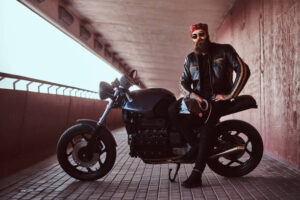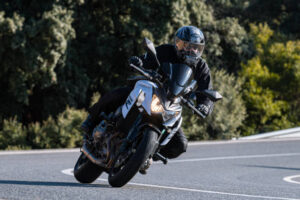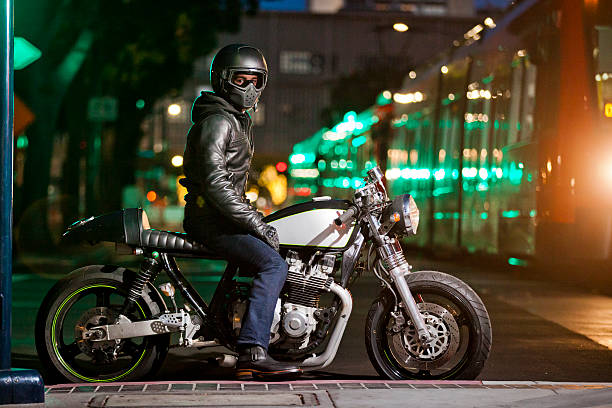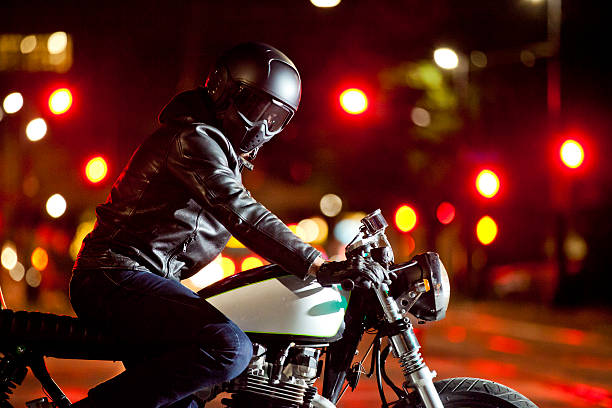A Comprehensive Comparison of Traditional and Modern Bicycle Leather Cuts
Leather clothing has always been associated with the motorcycle community, where leather cuts bikers wear are fashionable but also practical and protective. Contemporary leather cuts reflect developments in technology, fashion, and motorcycle culture.

Traditional leather jackets were valuable and protective. Early riders used thick leather coats to prevent road rash and weather damage. These simple aviator or military jackets had thick belts and broad lapels that could be turned up to protect the face from the wind.
Due to their thickness and durability, cowhide and horsehide were used nearly exclusively for these cuts. These materials’ intrinsic abrasion resistance made them perfect for bikers. Marlon Brando wore the Schott NYC Perfecto motorcycle jacket in The Wild One in 1953. Asymmetrical front zipper, snap-down lapels, and belted waist define the Perfecto. This style defined the classic motorcycle jacket.
Today, leather cuts come in various shapes and materials, including lambskin and imitation leather. Modern technology has improved safety and comfort by using breathable materials and superior armor padding that meet safety standards without sacrificing comfort.
Contemporary biker jackets are sleeker and more fitted, appealing to a broader audience. Removable linings, ventilation zippers, and elastic sections offer comfort and protection. This trend is led by Dainese and Alpinestars, which make riding and casual jackets.
Women’s jackets are another significant change. Women motorcyclists first wore more petite men’s jackets that were ill-fitting and uncomfortable. Today, producers make women’s leather jackets that are safe and valuable but fit women. This transition in motorcycle gear is part of a more significant riding inclusion movement.
Leather coats have also changed color. Modern jackets come in many colors, but black is still popular since it hides dirt and grease and symbolizes rebellion and toughness. Bright colors and reflective materials are becoming more common, improving road visibility and safety.
Technology is one of the most significant changes in biker leather cutting. Modern designs have GPS trackers, Bluetooth connectivity, and fall-detection road rash protection. Technological advances in riding apparel have combined style and usefulness in ways that were unimaginable in the past.
Cultural changes have also influenced the biker jacket style. Motorcycle groups and popular media have produced subcultures of bikers with different leather cut preferences. Outlaw bikers may select rugged leather jackets to express their individuality, while urban riders may prefer sophisticated, fashionable cuts that complement their lifestyle.
Despite these advances, traditionalists and modernists argue. Modern jackets are adaptable and attractive, but purists say they lack the protection and durability of traditional leather cuts. They feel that historical designs had an unequaled character and authenticity that united riders with their clothes, as newer designs may not.
Modern leather cut proponents say material and design innovations have made jackets more comfortable, safer, and accessible to a diverse population of riders. They say textile technology, incredibly waterproof yet breathable membranes, has changed motorcycle gear, making conventional materials and designs outdated.
Finally, biker leather cuts, whether classic or modern, are a fascinating tapestry of history, technology, and style. Each has pros and cons, and motorcyclists today should choose a style and material that meets their demands, whether they value protection, comfort, or aesthetics. The variety of biker attire allows for a more individualized and expressive riding experience, commemorating the old and embracing the modern.

Strategic Leather Cuts Improve Biker Safety
For years, motorcycle riders have preferred leather for its safety and traditional look. However, the styles and leather cuts bikers choose can affect their safety. This study will examine how leather cuts improve biker safety, including material qualities, cut variations, and integrated safety technology.
Leather’s main safety attribute is its natural abrasion resistance. When thrown from a motorcycle in an accident, skidding on pavement can inflict severe road rash. Leather works as a second skin, protecting the biker from the road. Traditional cowhide and horsehide leathers used in rider jackets and leggings provide this protection owing to their thickness and toughness.
Cut is vital to leather garment protection. Traditional cuts were looser to allow more movement. Unsecured clothing can capture air in a high-speed crash, pulling the rider into danger. As a result, current leather cuts are more form-fitting, which decreases drag and keeps padding and armor in place to protect elbows, shoulders, and backs.
Kevlar or other synthetic stretch panels are also common in modern leather clothing. High-mobility areas, including the inner arms, crotch, and back of the knees, receive these panels. The leather cut’s incorporation of these materials improves the rider’s range of motion and garment durability. This is crucial because it keeps leather from bunching up or restricting movement during a ride, which can distract or impair motorcycle control.
The placement and design of zippers and closures improve leather cut safety. Heavy-duty, protected zippers withstand pavement slips. Strategic seam placement increases a garment’s rip resistance. Double- or triple-stitched seams away from high-impact zones keep the garment intact during accidents, preventing abrasions.
Modern leather cuts use reflective elements for safety. Although ancient leather gear did not boost a rider’s visibility, modern garments typically have fluorescent piping or panels to help riders be seen at night or in low light. This crucial safety element reduces crashes by increasing visibility.
Modern leather cuts feature increased ventilation for safety. Proper ventilation keeps riders calm and alert, reducing heat fatigue. Perforated panels or zippered vents on leather coats and pants provide airflow without compromising protection.

Other advantages of modern leather jackets and pants include seamless integration with spine protectors and impact-absorbing vests. These things can be connected to jacket linings or garments with Velcro strips. This modular biker safety system lets riders adjust their protection to meet their riding situations and preferences.
Even though leather cuts have improved, personal preference and riding style frequently determine the style. Some motorcyclists love old leather, but others choose current cuts for better protection, comfort, and utility. No matter the style, leather protects riders.
Leather biker gear design innovation shows the industry’s commitment to rider safety. Manufacturers can create fashionable, comfortable, and safe leather clothes using rider feedback and the newest textile technology. This proactive attitude keeps leather a reliable and popular choice for bikers as armor and fashion.
In conclusion, leather biker gear is valued for its style and culture as well as its safety. Riders benefit from leather apparel’s strategic cuts and deliberate integration of current materials and technologies, which boost its protective functions. Leather cuts will evolve with biking, improving the biker’s flair and safety.





Leave a Reply